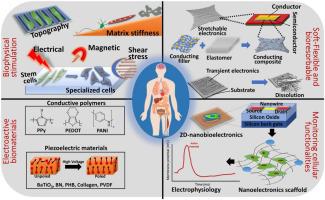Materials Science and Engineering: R: Reports ( IF 31.0 ) Pub Date : 2021-07-12 , DOI: 10.1016/j.mser.2021.100630 Asish Kumar Panda 1 , Bikramjit Basu 1, 2

|
The field of bioelectronic medicine has witnessed significant developments over the last two decades. However, the ability to precisely control the cell functionalities remains a major constraint in translating research outcomes to implantable bioelectronic devices. Various biophysical cues such as matrix stiffness, mechanical forces, substrate topography, and external electrical stimulation are being investigated to modulate cellular functions. In this perspective, the bioengineering approach of integrating electronic systems with biomaterial scaffolds can be adapted to monitor the cellular physiology within the engineered tissue. In this critical review, we have comprehensively analysed the applications of electroactive biomaterials to deliver bioelectrical cues for regulating cell fate processes. Along with the fundamental physical phenomenon at the tissue-electrode interface, the advancements in nanoelectronic devices in pre-clinical and clinical studies have been summarized. While the stiff and rigid electronics bring-forth the challenges in the biointegration and electrical performance; soft and flexible electronics, in contrast, have emerged as next-generation bioelectronic devices with a more stable and compatible biointerface. We have outlined various state-of-the-art approaches to develop bioresorbable electronics that can be eliminated from the body after a stipulated time, without further intervention. In addition, clinically-led bioelectronics medicine to regulate the electrical signaling at the neural interface has been highlighted. In summary, this review envisions the strategies of biomaterials-based biophysical stimulations to be adopted in bioelectronics-based advanced tissue engineering approaches that may eventually allow us to potentially realize the development of bioartificial organs.
中文翻译:

基于生物材料的生物电子医学生物工程策略
在过去的二十年中,生物电子医学领域取得了重大进展。然而,精确控制细胞功能的能力仍然是将研究成果转化为可植入生物电子设备的主要制约因素。正在研究各种生物物理线索,如基质刚度、机械力、基质形貌和外部电刺激,以调节细胞功能。从这个角度来看,将电子系统与生物材料支架相结合的生物工程方法可用于监测工程组织内的细胞生理学。在这篇批判性评论中,我们全面分析了电活性生物材料在提供生物电信号以调节细胞命运过程中的应用。除了组织电极界面的基本物理现象外,还总结了纳米电子设备在临床前和临床研究中的进展。而刚性和刚性的电子设备带来了生物整合和电气性能方面的挑战;相比之下,柔软而灵活的电子设备已成为具有更稳定和兼容的生物界面的下一代生物电子设备。我们概述了各种最先进的方法来开发可在规定时间后从体内清除的生物可吸收电子设备,无需进一步干预。此外,用于调节神经接口电信号的临床主导的生物电子医学也得到了强调。总之,



























 京公网安备 11010802027423号
京公网安备 11010802027423号